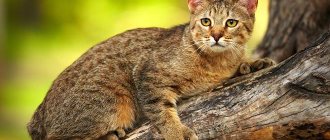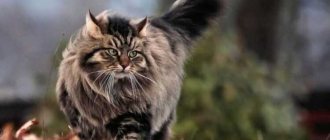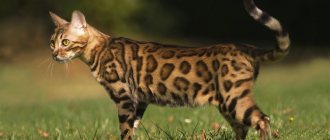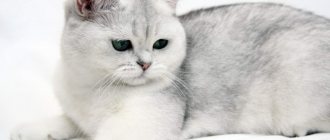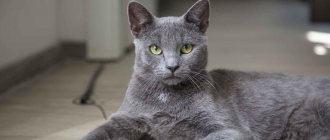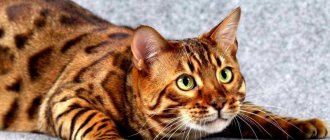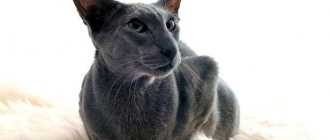This unique breed has many advantages that a person may not even be aware of. The photo of an oriental cat does not look quite ordinary.
At first glance, the appearance of thin cats with long ears may seem comical, but in fact, representatives of this breed have a wonderful character that owners cannot help but like.
A little history
In the 19th century, the Siamese cat became a guest at an English exhibition, where its appearance became a real sensation.
Later, breeders began crossing Siamese with female shorthaired breeds. This is how the Oriental cat breed was developed.
Similar cat breeds
Oriental cats successfully combine the characteristics of Asian and European breeds, since they were bred with the participation of both groups. Despite all the differences, Orientals are very similar to other breeds of the Siamese-Oriental group: Balinese, Siamese, Peterbald and Seychelles.
Each of these breeds has a beautifully built, graceful body, long limbs, a wedge-shaped muzzle and other characteristics that allow them to be combined into one group.
Breed standard
- Torso. The animal is of medium size and has a thin constitution. Its body is elongated with well-developed muscles, its tail is thin, and its legs are high.
- Head. The breed is characterized by a flat forehead, a thin and elongated nose, and a narrowed chin. The muzzle has an elongated, wedge-shaped shape.
- Ears. They are large in size, with a wide base that becomes pointed at the ends.
- Eyes. Slanting, almond-shaped, green.
- Wool cover. The coat is short and shiny, there is no undercoat.
- Color. All kinds of varieties except white.
Description of the breed
The Oriental cat, according to the description of the breed, looks like a typical Asian. The body of the animals is graceful, elongated, lean (but not skinny), with developed muscles. Disadvantages include too protruding pectoral cartilage.
Adult orientals reach average sizes: males weigh 6-8 kg, females up to 5 kg.
Head
According to the World Cat Federation standard, the Asian woman's head is wedge-shaped, forming a perfect equilateral triangle.
The muzzle should be narrowed, with a clearly defined jawline, and a prominent profile.
Eyes
The eyes are large, almond-shaped, without a depression on the bridge of the nose. Strabismus is a disqualifying feature.
The color of the iris must be green. Blue or multi-colored (one green, the other blue) eyes are acceptable only for completely white individuals.
Ears
The ears are the most noticeable feature of the breed. They are very large, thin, slightly rounded, wide at the base. The line of the ear cartilage continues the line of the wedge of the head.
The most intensive growth of shells occurs in the first three months of a kitten’s life; as the body develops, the animal’s ears become more proportional.
Neck
Sufficiently long, smooth, graceful, continues the line of the chin.
Nose
It is the nose that makes this cat breed look like a Georgian. It is elongated, smooth, and continues the line of the forehead and chin.
A purebred cat has no signs of snub nose.
Paws
The limbs are slender, very long and graceful. The front ones are slightly shorter than the rear ones. The paw pads are miniature and round in shape.
Individuals with underdeveloped, weak hind legs are not allowed for breeding.
Tail
Very long, whip-like, pointed at the tip. The thickness along the entire length should be the same.
Disqualifying faults include kinks on the tail.
Wool
In Oriental Shorthair cats, the coat is satiny, smooth, shiny, and clearly outlines the contours of the body.
Oriental longhaired cats have fine, silky hair that lies close to the body. They don't look very fluffy.
The presence of developed undercoat is unacceptable for animals of both types. For Oriental long-haired individuals, the defect is a double coat.
Colors
The Oriental cat breed standard allows for a wide variety of colors. The basic types include the following coat colors:
- lilac (lavender) – lilac with a warm pinkish tint and a touch of gray hair. The pads of the nose and paws are pale lilac;
- blue – cold, rich. The pile is colored evenly from the roots to the tips. Different shades of bluish-gray are allowed, but light ones are preferred;
- red (red) – warm, without other shades or patterns;
- Havana (chocolate) – rich chestnut, with uniform coloring;
- cinnamon is light, reddish brown. It is quite rare;
- faun (beige) – looks like the coat color of a young fawn;
- oriental ebony (black) – very stylish, uniform. Insertions of other colors are not allowed. The paw pads and nose should be black;
- cream;
- smoky - the main color of the coat is any of the acceptable ones, but the roots of the hairs are not dyed;
- A white cat should not have spots of a different shade or yellowness. The nose and paws are pink.
Tabby Orientals can be:
- marble;
- brindle;
- tortoiseshells;
- ticked.
Bicolor variants of the color of an oriental cat are acceptable, when the main tone alternates with white spots.
oriental cat photo
Characteristics of a pet
An owner who wants to get a pet will need the following information: the character and description of the oriental cat.
These energetic animals have a good disposition. Cats are trusting of people and quickly become attached to them. If the owner takes care of his pet, then he will always be surrounded by boundless love.
A sociable cat requires a lot of attention. If a person is constantly busy, he should not choose such a pet. Or he can get a couple of cats at once; the two animals will not be bored.
Among the characteristics of the breed, one can note a gentle voice; pets love to talk with people. Cats are always in a great mood and are ready to play with their owner as soon as he has free time.
Adult pets remain energetic and active throughout their lives. If you take a kitten into your home, it quickly finds a common language with other pets.
Character of the breed
Unlike their close relatives, Siamese cats, Orientals are devoid of aggression and vindictiveness. They are very affectionate animals that need constant human interaction. Long-eared Asians tolerate loneliness extremely poorly. People who spend whole days at work should not have such cats.
In terms of character, “Georgians” are similar to dogs. They treat all family members well, but they choose only one owner. They follow him on his heels, watching the actions of their loved one. They feel the mood subtly, always try to support and cheer.
Attention! If you transfer an adult Oriental to a new owner, the cat will experience separation from the previous owner extremely hard. May fall into prolonged depression.
Oriental beauties never become couch potatoes. They retain a playful, active disposition until old age. They love to be the center of everyone's attention, as well as jump, run, climb cabinets, and swing on curtains. Pets are very “talkative”; any of their actions are accompanied by loud meowing. Extremely curious. It is vital for them to explore all closed cabinets, containers and rooms in the house.
Orientals have a sharp mind. They can be taught to carry out simple commands and fetch. In a playful way, the pet easily learns new skills and rules of behavior in the house. They are not prone to mischief, but they can get into trouble out of boredom or curiosity. When raising a playful little Asian, you will have to show strength of character and consistency in actions.
Sociable pets love guests, often communicate without problems with small children, and enjoy participating in games. They will not offend the baby, even if he accidentally pulls the cat’s tail or ears. They get along well with their own kind, but still prefer human society. Dogs are treated with caution, and over time they can become friends.
Orientals are very similar to the Javanese breed
How to care for your pet
Owners should not devote much time to representatives of this breed. Short hair is easy to comb; you should start brushing from the head towards the tail.
It is recommended to bathe cats for preventive purposes. This needs to be done every year.
Interesting Facts
One of the main factors influencing the choice of breed is hypoallergenicity. In addition, Oriental cats hide many secrets that potential owners will be interested to know about:
- due to the incredible number of colors, Orientals are often called rainbow cats;
- due to the lack of undercoat, they cannot be kept like ordinary yard animals;
- the breeds in which genetic pathologies are almost completely absent can be counted on one hand - and Orientals are also on this list;
- good living conditions will ensure that your beloved pet stays next to its owner for up to 20 years - this is a long-lived breed;
- before registration, the Oriental breed was called one-color coffee Siamese;
- constant need for tactile contact, loud meowing in the absence of it;
- jealousy, sometimes completely unfounded - towards a thing, toy or piece of furniture;
- there are cats with obvious strabismus, for which they can be excluded from participation in exhibitions and breeding work;
- reluctance to use claws;
- devotion to the owner is akin to that of a dog;
- voice timbre atypical for most representatives of the cat family.
One of the most interesting facts is the tendency to copy the actions of the owner. Because of this habit, it is sometimes easier to teach an Oriental cat to use the toilet than the tray intended for it.
How to take care of your eyes
Orientals wipe their eyes daily to remove all discharge.
The procedure is performed using a cotton swab or a piece of soft material, which is pre-moistened in water or tea leaves.
Features of feeding and diet
Due to the imperfection of the digestive system of Orientals, it is better not to experiment with the selection of natural food and choose industrial high-quality options. The main thing is not to mix dry and wet food during the same meal.
One of the main indicators characterizing properly selected food is the condition of the coat. It will be silky to the touch, soft and shiny. If dandruff or excessive hair fragility occurs, you should think about reviewing your diet.
How to care for your ears
The animal's huge ears require special attention. An oriental black cat or a pet with a different color has delicate skin, so rough manipulations are not acceptable.
For the cleaning procedure, prepare soft cotton swabs intended for hygiene procedures, Vaseline or oil. Do not make rough movements or press on the ears.
Advantages and disadvantages
Like any breed, Orientals have their advantages and disadvantages. You should definitely familiarize yourself with them if you are at the stage of choosing a pet. A description of the breed in terms of advantages will be as follows:
- exotic appearance;
- physical activity, playfulness;
- extreme intelligence;
- the ability to instantly grasp the mood of the owner;
- sociability;
- the desire to make contact, the need for affection and tenderness;
- unpretentiousness in care and maintenance;
- almost complete absence of genetic diseases;
- hypoallergenic.
It also has its drawbacks. Knowing them, you can easily determine whether this particular breed is right for you or not:
- quite touchy and vindictive;
- easily fall under the influence of the mood and habits of the owner;
- they need a huge amount of attention;
- competent organization of outdoor games and leisure is required;
- very selfish and jealous animals.
Orientals do not tolerate extreme cold and drafts well, so try to arrange their bed and playhouses in places protected from such external influences.
How to care for claws
It is recommended to cut your nails every month. To avoid causing pain to your pet, you should trim a maximum of 2 mm.
For the procedure, use sharp nippers; accustom the kitten to nail hygiene from the moment it appears in your home; trim one nail per week.
Maintenance and care
Oriental cats do not require any special or labor-intensive care. Thai long-eared cats prefer to take care of the cleanliness of their fur themselves, which, by the way, they do quite well. The owner just has to buy a rubber mitten to clean off loose hairs from the pet’s body during seasonal shedding. The same procedure can be carried out using an ordinary damp cloth: shedding wool easily sticks to damp matter. It is generally not recommended to bathe Orientals. An exception can only be made for an animal that is too dirty or for individuals preparing for an exhibition.
Sleepy kingdom
Cats have their ears cleaned no more than once a week. No special equipment is required for this procedure, except for a cotton swab and disinfectant lotion, which can equally well replace regular Vaseline. Regularly examine your pet's eyes, removing accumulated dirt and mucus with a cotton pad soaked in boiled water. Ideally, Oriental cats should also have their teeth brushed, but in practice, few owners want to participate in this painstaking process. If for some reason you are unable to treat your pet’s oral cavity, try to minimize the risk of plaque and tartar by purchasing dry food. Densely pressed “drying” croquettes do a good job of cleaning teeth and are quite capable of replacing a regular brush. For animals that eat wet canned food, you can buy special veterinary treats for dental plaque (sausages and bones for dogs are suitable).
Caring for an Oriental cat's claws begins with the purchase of a scratching post. But since the nail plate of representatives of this breed grows quite intensively, once a month they should have a “pedicure” session. Shorten the claw by no more than 2 mm, otherwise there is a risk of injuring your pet’s skin. If the cat actively resists during the process, it is better to involve an assistant in the matter and stretch out the “pleasure” for several days.
Orientals have one not very pleasant trait - they love to taste indoor flowers. If a green-eyed kitten of this breed appears in your home, it is better to remove Dieffenbachias, azaleas and other plants that are poisonous to cats from his field of vision. The same applies to open windows. For the gutta-percha “Asian”, falling out of them is a matter of a few seconds.
Feeding
You won’t be able to save money on buying industrial food with oriental: the digestive system of the lop-eared “Thais” is simply not able to properly digest the food from your table. So, in the case of food, the owner of an Oriental cat has only two options: treat the pet with wet canned food or transfer it to “drying”. By the way, cats themselves prefer the first option, while their owners are more focused on dry food, which is cheaper and lasts longer. If you want to please your pet, but not at the expense of your own comfort, try alternating between canned food and dry food. The only thing you shouldn’t do is mix both types of food in one feeding.
Within Temptation
Sometimes an eared cat can be pampered with natural products, for example, a piece of lean meat, fish fillet, or oatmeal with milk. But you shouldn’t organize such belly celebrations too often. Firstly, the pet will quickly get used to the treats, which can lead to a loss of interest in commercial food. Secondly, such gluttony leads to obesity, to which Orientals are already prone. The cat's daily menu should not be very varied, so that the animal is not tempted to eat in reserve. Choose a suitable type of premium food for your mustachioed friend (options for Siamese cats are suitable) and do not deviate from the set course.
Oriental merle cat
Note: you can determine how suitable a particular type of food is for a cat by the condition of its fur. A soft, glossy coat without signs of dandruff indicates that the diet has been chosen correctly.
To discourage your Oriental cat from overeating, always leave enough food in her bowl. It is undesirable to feed an animal on a schedule, since pets regard this as the threshold of a serious hunger strike and consume more food than they need.
For the normal functioning of all body systems, it is useful to mix vitamin-mineral complexes into the food of Orientals. In particular, calcium and taurine supplements are recommended for young individuals. And of course, do not forget to provide the animal with round-the-clock access to clean water.
Toilet
Orientals are very smart and clean cats. Usually 3-month-old babies from the nursery already know what a tray is and how to use it correctly. If the kitten stubbornly continues to walk past the toilet, it is important to understand that he is not doing this out of harm. The tray may be in the wrong place. For example, if the toilet is located in the bathroom, the animal may be irritated by the smell of household chemicals.
It is better if the tray is in a secluded corner where no one will see the baby and where he can truly relax. A kitten sitting down to relieve itself in the wrong place must be frightened, but this should be done in such a way that the animal does not understand that the source of the threat is the owner. For example, you can clap your hands loudly, spray the Oriental cat with water from a spray bottle, or throw some kind of soft toy at it.
Contents of orientals
Before you get a pet, you will need to make sure that the cat has everything it needs. Your pet needs a place to sleep.
Buy a suitable cat house, toilet, toys, scratching post, and special care products for him.
Tips for choosing a kitten
Purchasing a kitten should only be done from trusted breeders or nurseries with a good reputation. The following must be taken into account:
- the kitten must be at least 3 months old;
- All documents must be present: birth certificate or pedigree, veterinary passport indicating the vaccinations;
- cats and kittens must be kept in good conditions;
- the appearance and behavior of the parents fully meet the requirements of the breed standard.
Observe the kitten, examine it: some isolation is allowed if the animal was kept in a cage. In any case, outwardly the baby should not raise any questions regarding health: there should be no inflammation, tumors, runny nose or other manifestations of a painful condition.
Who is not recommended to have an ori?
The Oriental breed is a companion cat. If you disappear all day at work, then it will be difficult for them to endure regular loneliness. It is undesirable to take an Oriental into a house where there are already animals: this can lead to a conflict due to the “redistribution of zones of influence.” The Oriental will fight for the owner's attention, creating a tense situation over and over again.
What to feed your pets
It is necessary to ensure that the diet is of high quality. You should not give your cat food from the table. His food should not be too spicy or too salty.
Siberian cat - history of the breed, description, character and habits + 95 photos- Maine Coon - history of occurrence, description of the breed, character + 84 photos
- Burma - a cat as a mascot, hygiene and health, character of the breed + 96 photos
Fatty foods are harmful to Orientals. Premium ready-made food is a balanced menu that will benefit your pets.
The animal must be fed at least 2 or 3 times a day. If you want to wean your pet off food, do it gradually. Pour new food into his bowl along with the old one, increasing the dose of the first over time.
Oriental health, life expectancy
Cats of this breed have good health. But since the Oriental breed is artificially bred, its representatives may be susceptible to certain diseases. To prevent them, the health of these cats must be kept under constant monitoring.
The health of Orientals must be protected; they do not have a warming undercoat.
The animal should not be exposed to drafts; windows and doors must be closed so that it does not catch a cold. Due to the lack of undercoat, Orientals get very cold and cannot live outside.
The following diseases are typical for Oriental cats:
- Amyloidosis of the liver. The disease is a disruption of metabolic processes in the liver. As a result, an uncharacteristic protein-polysaccharide complex is formed - amyloid. This leads to dysfunction of the liver, its rupture or hemorrhage in it. This disease cannot be cured, it is inherited, and if it is noticed at an early stage, then with the help of treatment it is possible to maintain a fairly high standard of living for the cat.
- Cardiomyopathy is a disease of the heart muscle (myocardium), in which the cavities of the heart are stretched. At an early stage of development, this disease can be slowed down, but cannot be cured.
- Asthma is a practically incurable disease. It may arise due to a close relationship with Siamese cats. During the manifestation of the disease, the cat inhales air with great difficulty, making painful efforts to do so. Asthmatic asthma attacks are dangerous not only for the cat’s health, but also for his life. When the attack stops, the Oriental should be taken to the veterinarian to begin treatment immediately. It will alleviate the animal’s condition and allow it to achieve long-term remission.
- Baldness. It is associated with a lack of vitamins, minerals in the animal’s body, endocrine system disorders, or the fact that the cat’s parents were close relatives.
- Flat chest syndrome is an inherited condition that causes changes in the bony base of the sternum. The consequences of the disease are characterized by the fact that the animal’s lungs do not open completely, the kitten’s breathing is difficult, and it cannot fully exhale due to the severe limitation of oxygen access to the cells and tissues of the brain. This disease is observed only in kittens, which due to their young age can lead to their death. Weak signs of chest deformation give the kitten a chance to survive. The chest improves with age.
- Gingivitis. Occurs as a result of infection from tartar. Signs of the disease include severe drooling, refusal to eat, and bad breath. A preventative measure is systematic teeth brushing.
- Progressive retinal atrophy. It can appear at any age. This hereditary disease threatens the animal with partial or complete loss of vision. The disease occurs without symptoms and is usually detected when visiting a veterinarian. If the disease is detected at an early stage, the process of vision loss can be slowed down.
Timely vaccination will help maintain the health of your Oriental cat. The first vaccination should be given at 3 months. Until this point, you need to treat the cat for worms. This procedure is carried out once every three months.
On average, Oriental cats live 15–17 years; with good care, they can live 20 years.
Oriental cats live on average more than 15 years
Their lifespan will become shorter if they suffer from the above diseases. Nutrition, proper cat care, and timely vaccination play an important role in the life expectancy of Oriental cats.
Photo of an oriental cat
Cost of Oriental breed cats
The cost of an Oriental breed kitten may vary depending on color and class.
- Price from 25 to 100 thousand rubles. There are some nuances that can cause the price to rise.
- If you take a kitten that will continue the lineage of purebred Orientals, then its price will be higher.
- The average price is 30-40 thousand rubles if you take a kitten for yourself. Also, if there are any deviations in the breed standard, the price may be reduced.
You can buy a cat of this breed at a cattery. An important factor is the study of the pedigree; kittens must have a certain set of documents confirming their belonging to the breed.
It is also worth noting that kittens are not given away before 1-2 months of age. If you have any doubts, you can always get additional information about the club or nursery where this breed is bred.

